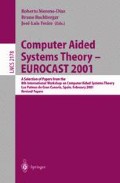Abstract
The paper, after some theoretical hints on the “morphogenetic neuron” proposes the use of this new technique to solve one of the most important themes in robotics, the manipulator kinematics structure representation and the following solution of the inverse kinematics problem. Even if the application has been completed and fully tested with success only on a two degrees of freedom SCARA robot, the first results here reported obtained on a more complex manipulator (spherical) seem to confirm the effectiveness of the approach.
Access this chapter
Tax calculation will be finalised at checkout
Purchases are for personal use only
Preview
Unable to display preview. Download preview PDF.
References
Dhingra A. K. Almadi A. N., Kohli D., Closed-form displacement analysis of 8,9, and 10-link mechanisms. Part I: 8-link 1-DOF mechanisms, Mechanism and Machine Theory, pag. 821–850, vol. 35, 2000.
Dhingra A. K. Almadi A. N., Kohli D., Closed-form displacement analysis of 8,9, and 10-link mechanisms. Part I: 9-link 2-DOF and 10-link 3-DOF mechanisms, Mechanism and Machine Theory, pag. 851–869, vol. 35, 2000.
Faglia R., Tiboni M., Solving the inverse kinematics problem of industrial manipulators by a back propagation neural network., 5th IASTED, 29–31 Maggio 1997, Cancun, Mexico.
Faglia R., An Overview of Innovative Methods for the Robotic Inverse Kinematics Problem Solution, Invited paper. Atti del Second International Conference, CASYS.98 (Computing Anticipatory Systems), Agosto 1998, Liegi, Belgio. Published also by AIP (American Institute of Physics), n.465.
Faglia R., Resconi G. A new Methodology for the inverse Kinematics problem solution in robotics. The 3rd World Congr. on Computational Mech. Chiba, Japan, 1994.
Feldman J., Minimization of Boolean complexity in human concept learning, Nature vol.407, pag.630–633, 5 October 2000.
Kapur D., Lakashman Y.N., Elimination Methods: An Introduction, Symbolic and Numerical Computation for Artificial Intelligence, Academic Press, 1992.
Lee H.-Y., Reinholtz C. F., Inverse Kinematics of Serial-Chain Manipulators, Transactions of the ASME, pag.396–404, vol. 118, September 1996.
McCullough, Pitts W.H., A logical calculus of the ideas immanent in nervous activity, Bull. Math. Biophys. 5, 115–133, 1943.
Moses, J., Solution of Systems of Polynomial Equations By Elimination,SMART Collection: cacm-1387, August 1966.
Murre J.M.J., Learning and categorization in modular neural networks, Erlbaum, Hillsdale, NJ, 1992.
Nobuo S., The extent to which Biosonar information is represented in the Bat Auditory Cortex, in: Dynamic Aspects of Neocortical Function, ed. G.M. Edelman, John Wiley, New York 1984.
Raghavan M., Roth B., Inverse Kinematics of the General 6R Manipulator and Related Linkages, Transactions of the ASME, pag. 502–508, vol. 115, September 1993.
Raghavan M., Roth B., Solving Polynomial Systems for the Kinematic Analysis and Syntesis of Mechanisms and Robot Manipulators, Special 50th Anniversary Design Issue, pag. 71–79, vol.117, June 1995.
Resconi G., The morphogenetic Neuron in Computational Intelligence: Soft Computing and Fuzzy.-Neuro Integration with Application, Springer NATO ASI Series F Computer and System Science vol 162, pag.304–331, 1998.
Resconi G., Pessa E., Poluzzi R. The Morphogenetic Neuron, Proceedings fourteenth European meeting on cybernetics and systems research, April 14–17, 1998.
Resconi G., Van der Wal A.J., Ruan D., Speed-up of the MC method by using a physical model of the Dempster-Shafer theory, Int. J. of Intelligent Systems, Special issue on FLINS’96, Vol. 13, Numbers 2/3, pp 221–242, 1998.
Resconi G., Van der Wal A.J., A data model for the Morphogenetic Neuron, Int. J. General System Vol.29(1) pp.141–174
Resconi G., Van der Wal A.J., Single neuron as a quantum computer-morphogenetic neuron, Intelligent techniques and Soft Computing in Nuclear Science and Engineering, World Scientific, Proceeding of the 4th International FLINS Conference Bruges,Belgium August 28–30, 2000.
Throughman K. A., Shadmehn R., Learning of action though adaptive combination of motor primitive, Nature vol.407, pag.742–747, 12 October 2000.
Davis J. Heeger, Alex C. Huk, Wilson S. Geisler and Duane G. Albrecht, Spiker versus BOLD: what does neuroimaging tell us about neuronal activity? Nature neuroscience volume 3 no 7 july 2000 pag.631
Alexandre Pouget and Lawerence H. Snyder, Computational approaches to sensorimotor transformations to nature neuroscience volume 3 supplement November 2000 pag.1193.
Maximilian Riesenhuber and Tomaso Poggio MIT. Model of object recognition, nature neuroscience supplement volume 3 supplement November 2000 pag.1199.
Author information
Authors and Affiliations
Editor information
Editors and Affiliations
Rights and permissions
Copyright information
© 2001 Springer-Verlag Berlin Heidelberg
About this paper
Cite this paper
Resconi, G., Borboni, A., Faglia, R., Tiboni, M. (2001). Kinematics in Robotics by the Morphogenetic Neuron. In: Moreno-Díaz, R., Buchberger, B., Luis Freire, J. (eds) Computer Aided Systems Theory — EUROCAST 2001. EUROCAST 2001. Lecture Notes in Computer Science, vol 2178. Springer, Berlin, Heidelberg. https://doi.org/10.1007/3-540-45654-6_28
Download citation
DOI: https://doi.org/10.1007/3-540-45654-6_28
Published:
Publisher Name: Springer, Berlin, Heidelberg
Print ISBN: 978-3-540-42959-3
Online ISBN: 978-3-540-45654-4
eBook Packages: Springer Book Archive

